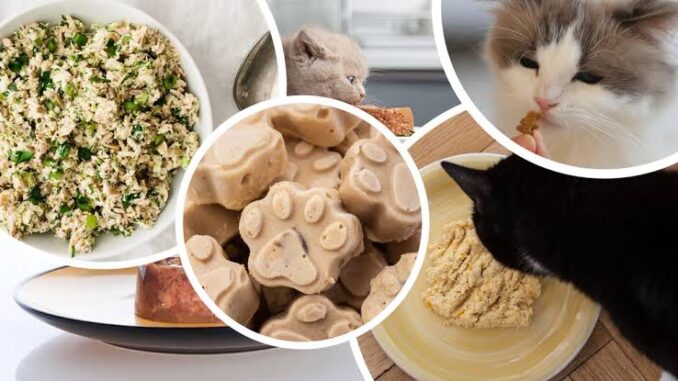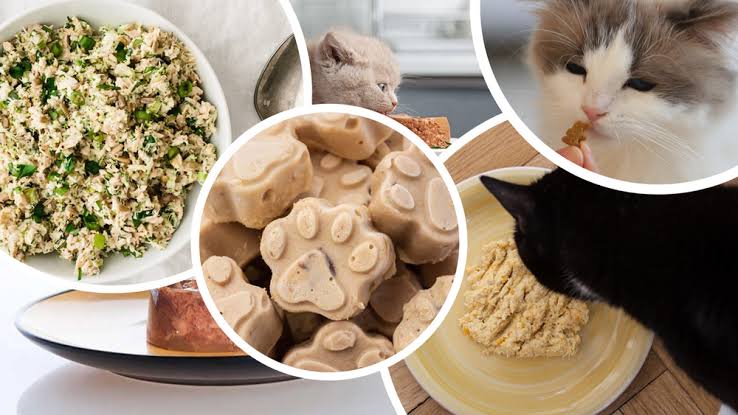
Homemade Cat Treat Recipes Your Feline Will Love: For most cat parents, our furry companions are more than just pets they’re family. And just like any loved one, we want to give them the best. One of the most fun and rewarding ways to do this is by making your own homemade cat treats. Not only are these treats delicious and nutritious, but they also let you control what goes into your cat’s diet, avoiding harmful additives, preservatives, or artificial flavors.

In 2025, more pet owners are going the DIY route in response to concerns over mass-produced pet foods and recalls. Whether your cat prefers chicken, tuna, or something a bit more adventurous, there’s a recipe here to suit every feline palate.
Why Make Homemade Cat Treats?
Before diving into the recipes, let’s explore why making your own cat treats is worth the effort:
- Control Over Ingredients: You avoid harmful fillers, artificial colors, and preservatives.
- Tailored Nutrition: You can address dietary needs (grain-free, low-fat, high-protein).
- Cost-Effective: Many treats use simple ingredients you already have.
- Bonding Opportunity: Making treats can be part of play and training.
- Allergy Management: Great for cats with food sensitivities or allergies.
Nutritional Guidelines for Cat Treats
Cats are obligate carnivores, which means they need high protein, moderate fat, and very low carbohydrate intake. When crafting treats:
- Protein Sources: Use chicken, turkey, salmon, tuna, or beef.
- Avoid: Onions, garlic, chocolate, caffeine, dairy, grapes, and raisins.
- Limit: Carbohydrates (like grains or sweet potatoes).
- Balance: Treats should not exceed 10% of your cat’s daily caloric intake.
Top 6 Homemade Cat Treat Recipes
1. Tuna Crunch Cat Bites
Best for: Fish-loving felines
Ingredients:
- 1 can tuna in water, drained
- 1 egg
- 1 tablespoon oat flour (or finely ground oats)
- 1 tablespoon parsley (optional, for breath)
Instructions:
- Preheat oven to 350°F (175°C).
- Mix tuna and egg in a bowl until well blended.
- Stir in oat flour to create a dough-like consistency.
- Roll small balls (about the size of a marble) and flatten slightly.
- Place on parchment-lined baking sheet and bake for 10–12 minutes.
- Cool before serving. Store in refrigerator up to 5 days.
Tip: Freeze extras for up to 1 month.
2. Chicken and Catnip Crumbles
Best for: High-protein training treats
Ingredients:
- ½ cup cooked chicken breast, finely chopped
- 1 egg
- 1 tablespoon coconut flour
- 1 teaspoon dried catnip
Instructions:
- Combine all ingredients into a thick paste.
- Form small bite-sized crumbles.
- Bake at 325°F (160°C) for 12–15 minutes.
- Let cool and serve sparingly.
Bonus: Great for clicker training or positive reinforcement.
3. Salmon Sweet Potato Stars
Best for: Omega-3 boost and sensitive tummies
Ingredients:
- ½ cup canned salmon, drained
- ¼ cup mashed sweet potato
- 1 egg
- 1 tablespoon ground flaxseed (optional)
Instructions:
- Mix all ingredients to form a thick batter.
- Roll out and cut into small shapes (stars, hearts).
- Bake at 350°F for 10–12 minutes.
- Store in airtight container up to 5 days.
Note: Sweet potato is fine in small amounts and provides fiber.
4. Turkey Liver Treats
Best for: Iron-rich rewards
Ingredients:
- ½ pound turkey liver (or chicken liver)
- 1 egg
- 1 tablespoon coconut flour
Instructions:
- Blend liver and egg into a smooth puree.
- Stir in flour for texture.
- Spoon onto baking sheet in pea-sized drops.
- Bake at 325°F for 20–25 minutes.
- Cool and refrigerate. Freeze if making in bulk.
Caution: Liver is nutrient-dense—don’t overfeed!
5. Cheesy Tuna Bites (Occasional Treat)
Best for: Cats who love dairy (in moderation)
Ingredients:
- 1 can tuna, drained
- 2 tablespoons grated cheddar cheese
- 1 egg
- 1 tablespoon oat flour
Instructions:
- Mix all ingredients together in a bowl.
- Form small dough balls and place on tray.
- Bake at 350°F for 10 minutes.
- Cool completely before serving.
Tip: Dairy can upset some cats. If unsure, test with a tiny portion first.
6. Freeze-Dried Chicken Cubes (No Bake)
Best for: Raw-friendly, minimal prep
Ingredients:
- 1 boneless chicken breast
Instructions:
- Steam or bake chicken until fully cooked.
- Cut into tiny cubes.
- Place in freeze-dryer or use freezer dehydration method.
- Store in sealed jar in cool area.
Note: These make excellent shelf-stable, single-ingredient treats.
READ ALSO: The Best Automatic Feeders for Dogs
Storage Tips
- Store most homemade treats in the fridge in an airtight container.
- Freeze in batches to prolong shelf life.
- Never feed moldy or spoiled treats—cats are sensitive to bacteria.
Tips for Success
- Use organic and hormone-free meats if possible.
- Blend ingredients well for texture uniformity.
- Always cool treats completely before serving.
- Introduce new ingredients slowly to avoid upset stomachs.
- Avoid onion powder, garlic powder, or high-salt seasonings.
FAQs
How often can I give my cat treats?
Treats should not exceed 10% of your cat’s daily caloric intake. For an average 10-lb cat, that’s roughly 20–30 calories from treats per day.
Can I substitute ingredients?
Yes, but carefully. Always keep the protein source high-quality and avoid toxic ingredients (onions, garlic, raisins, chocolate, etc.).
What if my cat has allergies or sensitivities?
Use hypoallergenic proteins (like rabbit or duck), avoid grains, and introduce one new ingredient at a time. Consult your vet before major dietary changes.
Are raw treats safe?
Raw diets are debated. If you go this route, freeze raw meat before prepping to kill parasites. Ensure excellent hygiene and avoid cross-contamination.
Can I use flour or grains in treats?
Many cats tolerate small amounts of rice or oat flour. Avoid wheat if your cat is grain-sensitive. Coconut flour is a good gluten-free alternative.
How do I know if my cat likes a recipe?
Cats can be picky! Let them sniff it first. If they eat it eagerly or purr, you’re on the right track. If not, try a different protein or texture.
How do I store and preserve treats?
- Store in the fridge up to 5 days.
- Freeze for longer shelf life (1–2 months).
- Label with the date to ensure freshness.
Are homemade treats better than store-bought?
Generally, yes—if made correctly. You can control ingredients, avoid harmful chemicals, and customize nutrition to your cat’s needs.
Can kittens eat homemade treats?
Yes, in moderation and using simple recipes. Avoid rich or heavily seasoned treats. Stick to soft textures and basic proteins like chicken or fish.
How do I make treats crunchy or soft?
- Crunchy: Bake longer or dehydrate.
- Soft/Chewy: Bake for less time or use moisture-rich ingredients like mashed sweet potato or egg.
Leave a Reply
You must be logged in to post a comment.